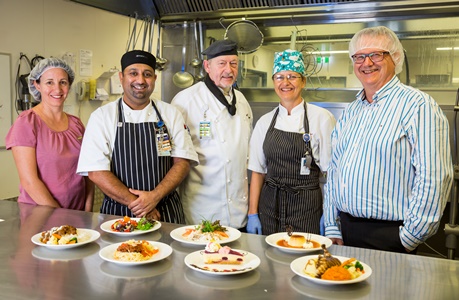 Malnutrition affects 35 per cent of the elderly in Queensland hospitals and people often need a high level of nutrition when hospitalised due to illness.
Malnutrition affects 35 per cent of the elderly in Queensland hospitals and people often need a high level of nutrition when hospitalised due to illness.
“As a result, strict guidelines for safety and nutrition are followed at St Andrew’s but
nevertheless taste is still a priority,” says St Andrew’s Head Chef Keith Munt.
“If the food doesn’t taste good, patients may find it unappetising and patients need to eat well to regain their health.”
Keith, who previously worked in the overseas airline catering industry, says his team of 10 chefs hail from across the world.
“We have chefs from Austria, Belgium, Germany, and various Asian and south east Asian countries all with various international experiences in resorts, five-star hotels and restaurants,” Keith said.
“Because of the multi-cultural diversity and broad overseas experience of our team of cooks and chefs, we can create meals that suit any ethnic group.”
Working closely alongside the chefs, is a team of Accredited Practising Dietitians including Senior Dietitian Sharyn Denmeade, who check and advise the chefs on all aspects of the menu planning to ensure all meals meet the required Queensland Health Nutritional Standards.
“The dietitians analyse all the menu recipes’ nutritional value, this includes checking each ingredient and providing direction on modifying recipes for improved nutritional value,” Sharyn said.
“Sometimes this involves recommending to chefs the use of a different brand for use across a broader patient group and/ or inclusion of other ingredients to improve the nutritional value of meals for patients.”
This strict process occurs across all items of the hospital menus, which are rotated on a 14-day cycle.
As well as nutrition, addressing the ever-growing area of food allergies and intolerances of patients is a major focus of St Andrew’s foodservice program.
To help manage patient’s food allergies and food intolerances, St Andrew’s uses Delegate, an electronic menu system set up by the dietitians to remove any food items and recipes from a patient’s menu selection if it contains a food the patient has
a reaction to.
Also key is communication between clinical and food service staff. Hospital admissions for severe allergic reactions have doubled for adults over the last decade while increasing five-fold for children in Australia.
Sharyn says there is no clear reason why food allergies are on such a rapid rise.
“Many food allergies are not severe and most children will grow out of them,” Sharyn said. “Allergies to nuts, seeds and seafood are likely to be life-long allergies developed as a child and continued into adulthood.”
Sharyn says reactions to food are usually immediate and can be severe and even life-threatening with symptoms including swelling, hives, eczema, diarrhea, vomiting, breathing difficulties and anaphylaxis.
She says food intolerances are more common than food allergies and are not life threatening.
Intolerances may include reactions to wheat, gluten, lactose, fructose, additives and naturally occurring chemicals such as salicylates, amines and glutamates.
“Reactions can take hours to days and are dependent on how much of the food that the
person is intolerant to has been consumed. Symptoms include hives, skin rashes, headaches, digestive problems, asthma and eczema,” Sharyn said.
St Andrew’s whole team approach and commitment to delivering tasty and nutritional
food that accommodates various food allergies and intolerances has been reflected well in patient satisfaction surveys.
 More than 90 per cent of patients at St Andrew’s rated their satisfaction with the
More than 90 per cent of patients at St Andrew’s rated their satisfaction with the
hospital’s patient foodservice as either very good or good according to a validated Acute Care Hospital Foodservice Patient Satisfaction Questionnaire conducted in late 2015.
The survey gauged food quality, meal service quality, staff/service issues, physical environment, meal size, hot foods, hunger and food quality and overall satisfaction.
Keith says despite the huge array of foods including 28 soups, mild curries, vegetarian and ethnic dishes, the traditional roast is still by far the most popular choice for patients at St Andrew’s. “I think this shows, in particular for our long-stay patients, that people look for ‘comfort food’ or food that reminds them of home,” Keith said.
To create a more homely dining experience for long-stay patients, St Andrew’s recently revamped its dining room for the patients in the rehabilitation ward. Focusing on the communal dinning experience as part of the rehabilitation recovery process, this allows selected patients from the rehabilitation ward to enjoy their meals in a social environment.